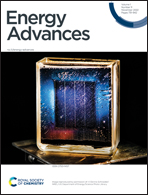Modulating oxygen vacancies of CeO2 nanospheres by Zn-doping: an efficient electrocatalyst for N2 reduction under ambient conditions†
Abstract
At present, most industrial NH3 production comes from the Haber–Bosch process, which causes a series of serious environmental pollution problems. Electrochemical N2 reduction is regarded as a green pathway to deal with this problem. Recently, CeO2 has attracted much attention due to its high thermal stability. Metal doping with smaller ion radius is an effective strategy to regulate oxygen vacancies, increase the defect concentration and enhance the catalyst activity. Herein, we developed Zn-doped CeO2 nanospheres (Zn–CeO2) for the electrochemical NRR. In 0.1 M Na2SO4, Zn–CeO2 achieves a large NH3 yield of 29.01 μg h−1 mgcat.−1 and a high faradaic efficiency of 10.3% at −0.20 V vs. reversible hydrogen electrode, and it also shows good structure stability. The density functional theory (DFT) calculations revealed the reaction mechanism of NRR activity regulated by the doping metal.



 Please wait while we load your content...
Please wait while we load your content...